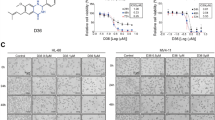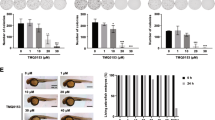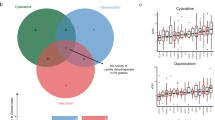Abstract
This study describes the mechanism of trolox and tiron induced potentiation of cytotoxicity caused by Ery5, an analog of magnolol, in human myeloid leukemia HL-60 cells. Ery5 induced cytotoxicity in HL-60 cells by involving activation of bax and cleavage of caspase 3, which contributed towards activation of both apoptotic and autophagic pathways. Trolox and tiron, even at non-toxic concentrations, contributed to the cytotoxicity of Ery5 by activation of autophagic proteins like ATG7, ATG12 and LC3-II. Z-VAD-fmk mediated reduction in the cytotoxicity and expression of autophagic proteins, further suggested that autophagy induced by Ery5 is largely dependent upon caspases. Interestingly, Ery5 induced autophagy was accompanied by the downregulation of PI3K/AKT pathway whereas, trolox and tiron strongly enhanced this effect. In addition to that treatment of cells with Ery5, trolox and tiron individually, displayed a marked upregulation of Bax. The involvement of Bax in trolox and tiron induced enhancement of the cytotoxicity of Ery5 was confirmed, when siRNA induced silencing of Bax led to increased viability of the cells and exerted a strong inhibitory effect on LC3-II accumulation and p62 degradation in case of cells treated by the combination of Ery5 with trolox or tiron. Additionally, an important role of PARP in Ery5 mediated cell death has been suggested by PARP silencing experiments, however, potentiation of autophagic cytotoxicity by trolox and tiron did not seem to be dependent on PARP-1. Therefore, Bax seems to play a vital role in trolox and tiron mediated potentiation of autophagic cell death by Ery5 in HL-60 cells.






Similar content being viewed by others
Abbreviations
- AO:
-
Acridine orange
- ATG:
-
Autophagy-related gene
- BH3:
-
Bcl2 homology 3
- LC3:
-
Microtubule-associated protein light chain 3
- MTT:
-
3-(4,5-Dimethylthiazole-2-yl)-2,5-diphenyltetrazolium bromide
- PARP-1:
-
Poly(ADP-ribose) polymerase-1
- PI:
-
Propidium iodide
- Rh-123:
-
Rhodamine-123
- ROS:
-
Reactive oxygen species
- siRNA:
-
Small interfering RNA
- Tiron:
-
4,5-Dihydroxy-1,3-benzene disulfonic acid-disodium salt
- Trolox:
-
6-Hydroxy-2,5,7,8-tetramethylchroman-2-carboxylic acid
- zVAD (zVAD fmk):
-
Benzyloxycarbonyl-Val-Ala-Asp fluoromethylketone
- SEM:
-
Scanning electron microscopy
References
Levine B, Klionsky DJ (2004) Development by self-digestion: molecular mechanisms and biological functions of autophagy. Dev Cell 6:463–477
Eisenberg-Lerner A, Bialik S, Simon H-U, Kimchi A (2009) Life and death partners: apoptosis, autophagy and the cross-talk between them. Cell Death Differ 16:966–975
Cheng Y, Ren X, Zhang Y, Patel R, Sharma A, Wu H, Robertson GP, Yan L, Rubin E, Yang J (2011) eEF-2 kinase dictates cross-talk between autophagy and apoptosis induced by Akt inhibition, thereby modulating cytotoxicity of novel Akt inhibitor MK-2206. Cancer Res 71:2654–2663
Teng CM, Chen CC, Ko FN, Lee LG, Huang TF, Chen YP, Hsu HY (1988) Two anti-platelet agents from Magnolia officinalis. Thromb Res 50:757–765
Chen JS, Chen YL, Greenberg AS, Chen YJ, Wang SM (2005) Magnolol stimulates lipolysis in lipid-laden RAW 264.7 macrophages. J Cell Biochem 94:1028–1037
Li HB, Yi X, Gao JM, Ying XX, Guan HQ, Li JC (2007) Magnolol-induced H460 cells death via autophagy but not apoptosis. Arch Pharm Res 30:1566–1574
Chuang ZC, Hsu SC, Cheng YT, Shao WS, Wu K, Fang GS, Ou CC, Wang V (2011) Magnolol down-regulates HER2 gene expression, leading to inhibition of HER2-mediated metastatic potential in ovarian cancer cells. Cancer Lett 311:11–19
Lee DH, Miroslaw-Jerzy S, Lee YJ (2009) Magnolol induces apoptosis via inhibiting the EGFR/PI3K/Akt signaling pathway in human prostate cancer cells. J Cell Biochem 106:1113–1122
Codogno P, Meijer AJ (2005) Autophagy and signaling: their role in cell survival and cell death. Cell Death Differ 12:1509–1518
Fujiwara K, Iwado E, Mills GB, Sawaya R, Kondo S, Kondo Y (2007) Akt inhibitor shows anticancer and radiosensitizing effects in malignant glioma cells by inducing autophagy. Int J Oncol 31:753–760
Wolter KG, Hsu YT, Smith CL, Nechushtan A, Xi XG, Youle RJ (1997) Movement of Bax from the cytosol to mitochondria during apoptosis. J Cell Biol 139:1281–1292
Gilmore AP, Metcalfe AD, Romer LH, Streuli CH (2000) Integrinmediated survival signals regulate the apoptotic function of Bax through its conformation and subcellular localization. J Cell Biol 149:431–446
Edlich F, Banerjee S, Suzuki M, Cleland MM, Arnoult D, Wang C, Neutzner A, Tjandra N, Youle RJ (2011) Bcl-xL retrotranslocates bax from the mitochondria into the cytosol. Cell 145:104–116
Yee KS, Wilkinson S, James J, Ryan KM, Vousden KH (2009) PUMA- and Bax-induced autophagy contributes to apoptosis. Cell Death Differ 16:1135–1145
Yu SW, Wang H, Poitras MF, Coombs C, Bowers WJ, Federoff HJ, Poirier GG, Dawson TM, Dawson VL (2002) Mediation of poly(ADP-ribose) polymerase-1-dependent cell death by apoptosis-inducing factor. Science 297:259–263
Althaus FR, Kleczkowska HE, Malanga M, Müntener CR, Pleschke JM, Ebner M, Auer B (1999) Poly ADP-ribosylation: a DNA break signal mechanism. Mol Cell Biochem 193:5–11
Halmosi R, Berente Z, Osz E, Toth K, Literati-Nagy P, Sumegi B (2001) Effect of poly(ADP-ribose) polymerase inhibitors on the ischemia-reperfusion-induced oxidative cell damage and mitochondrial metabolism in Langendorff heart perfusion system. Mol Pharmacol 59:1497–1505
Ha HC, Snyder SH (1999) Poly(ADP-ribose) polymerase is a mediator of necrotic cell death by ATP depletion. Proc Natl Acad Sci USA 96:13978–13982
Boulares AH, Yakovlev AG, Ivanova V, Stoica BA, Wang G, Iyer S, Smulson M (1999) Role of poly(ADP-ribose) polymerase (PARP) cleavage in apoptosis. Caspase 3-resistant PARP mutant increases rates of apoptosis in transfected cells. J Biol Chem 274:22932–22940
Decker P, Isenberg D, Muller S (2000) Inhibition of caspase- 3-mediated poly(ADP-ribose) polymerase (PARP) apoptotic cleavage by human PARP autoantibodies and effect on cells undergoing apoptosis. J Biol Chem 275:9043–9046
Zhang N, Chen Y, Jiang R, Li E, Chen X, Xi Z, Guo Y, Liu X, Zhou Y, Che Y, Jiang X (2011) PARP and RIP-1 are required for autophagy induced by 11′-deoxyverticillin A, which precedes caspase-dependent apoptosis. Autophagy 7:598–612
Muñoz-Gámez JA, Rodríguez-Vargas JM, Quiles-Pérez R, Aguilar-Quesada R, Martín-Oliva D, de Murcia G, Menissier de Murcia J, Almendros A, Ruiz de Almodóvar M, Oliver FJ (2009) PARP-1 is involved in autophagy induced by DNA damage. Autophagy 5:61–74
Huang Q, Shen HM (2009) To die or to live: the dual role of poly(ADP-ribose) polymerase-1 in autophagy and necrosis under oxidative stress and DNA damage. Autophagy 5:273–276
Chen Y, Mcmillan-Ward E, Kong J, Israels SJ, Gibson SB (2008) Oxidative stress induces autophagic cell death independent of apoptosis in transformed and cancer cells. Cell Death Differ 15:171–182
Underwood BR, Imarisio S, Fleming A, Rose C, Krishna G, Heard P, Quick M, Korolchuk VI, Renna M, Sarkar S, García-Arencibia M, O’Kane CJ, Murphy MP, Rubinsztein DC (2010) Antioxidants can inhibit basal autophagy and enhance neurodegeneration in models of polyglutamine disease. Hum Mol Genet 19:3413–3429
Karna P, Zughaier S, Pannu V, Simmons R, Narayan S, Aneja R (2010) Induction of reactive oxygen species-mediated autophagy by a novel microtubule-modulating agent. J Biol Chem 285:18737–18748
Jada S, Doma MR, Singh PP, Kumar S, Malik F, Sharma A, Khan IA, Qazi GN, Kumar HM (2012) Design and synthesis of novel magnolol derivatives as potential antimicrobial and antiproliferative compounds. Eur J Med Chem 51:35–41
Malik F, Kumar A, Bhushan S, Khan S, Bhatia A, Suri KA, Qazi GN, Singh J (2007) Reactive oxygen species generation and mitochondrial dysfunction in the apoptotic cell death of human myeloid leukemia HL-60 cells by a dietary compound withaferin A with concomitant protection by N-acetyl cysteine. Apoptosis 12:2115–2133
Bhushan S, Singh J, Rao JM, Saxena AK, Qazi GN (2006) A novel lignan composition from Cedrus deodara induces apoptosisand early nitric oxide generation in human leukemia Molt-4and HL-60 cells. Nitric Oxide 14:72–88
Kumar A, Malik F, Bhushan S, Shah BA, Taneja SC, Pal HC, Wani ZA, Mondhe DM, Kaur J, Singh J (2011) A novel parthenin analog exhibits anti-cancer activity: activation of apoptotic signaling events through robust NO formation in human leukemia HL-60 cells. Chem Biol Interact 193:204–215
Rello S, Stockert JC, Moreno V, Gámez A, Pacheco M, Juarranz A, Cañete M, Villanueva A (2005) Morphological criteria to distinguish cell death induced by apoptotic and necrotic treatments. Apoptosis 10:201–208
Diaz Z, Colombo M, Mann KK, Su H, Smith KN, Bohle DS, Schipper HM, Miller WH Jr (2005) Trolox selectively enhances arsenic-mediated oxidative stress and apoptosis in APL and other malignant cell lines. Blood 105:1237–1245
Ling YH, Liebes L, Zou Y, Perez-Soler R (2003) Reactive oxygen species generation and mitochondrial dysfunction in the apoptotic response to bortezomib, a novel proteasome inhibitor, in human H460 non-small cell lung cancer cells. J Biol Chem 278:33714–33723
Forrest VJ, Kang YH, McClain DE, Robinson DH, Ramakrishnan N (1994) Oxidative stress-induced apoptosis prevented by Trolox. Free Radic Biol Med 16:675–684
Viniegra JG, Martínez N, Modirassari P, Hernández Losa J, Parada Cobo C, Sánchez-Arévalo Lobo VJ, Aceves Luquero CI, Alvarez-Vallina L, Ramón y Cajal S, Rojas JM, Sánchez-Prieto R (2005) Full activation of PKB/Akt in response to insulin or ionizing radiation is mediated through ATM. J Biol Chem 280:4029–4036
Degtyarev M, De Mazière A, Orr C, Lin J, Lee BB, Tien JY, Prior WW, van Dijk S, Wu H, Gray DC, Davis DP, Stern HM, Murray LJ, Hoeflich KP, Klumperman J, Friedman LS, Lin K (2008) Akt inhibition promotes autophagy and sensitizes PTEN-null tumors to lysosomotropic agents. J Cell Biol 183:101–116
Rusten TE, Stenmark H (2010) p62, an autophagy hero or culprit? Nat Cell Biol 12:207–209
Finucane DM, Bossy-Wetzel E, Waterhouse NJ, Cotter TG, Green DR (1999) Bax-induced caspase activation and apoptosis via cytochrome c release from mitochondria is inhibitable by Bcl-xL. J Biol Chem 274:2225–2233
Kroemer G, Reed JC (2000) Mitochondrial control of cell death. Nat Med 6:513–519
Acknowledgments
We are thankful to Council of Scientific and Industrial Research, India for financial assistance to carry out this research work. We are also grateful to University Grants Commission, India, for providing research fellowship to Suresh Kumar.
Conflict of interest
The authors declare no conflict of interest.
Author information
Authors and Affiliations
Corresponding authors
Electronic supplementary material
Below is the link to the electronic supplementary material.
Rights and permissions
About this article
Cite this article
Kumar, S., Kumar, A., Pathania, A.S. et al. Tiron and trolox potentiate the autophagic cell death induced by magnolol analog Ery5 by activation of Bax in HL-60 cells. Apoptosis 18, 605–617 (2013). https://doi.org/10.1007/s10495-013-0805-y
Published:
Issue Date:
DOI: https://doi.org/10.1007/s10495-013-0805-y




